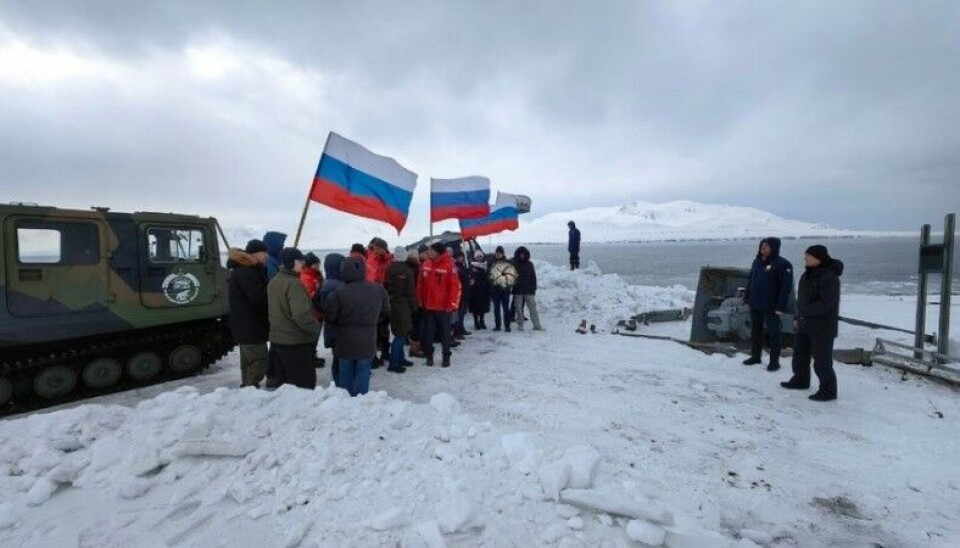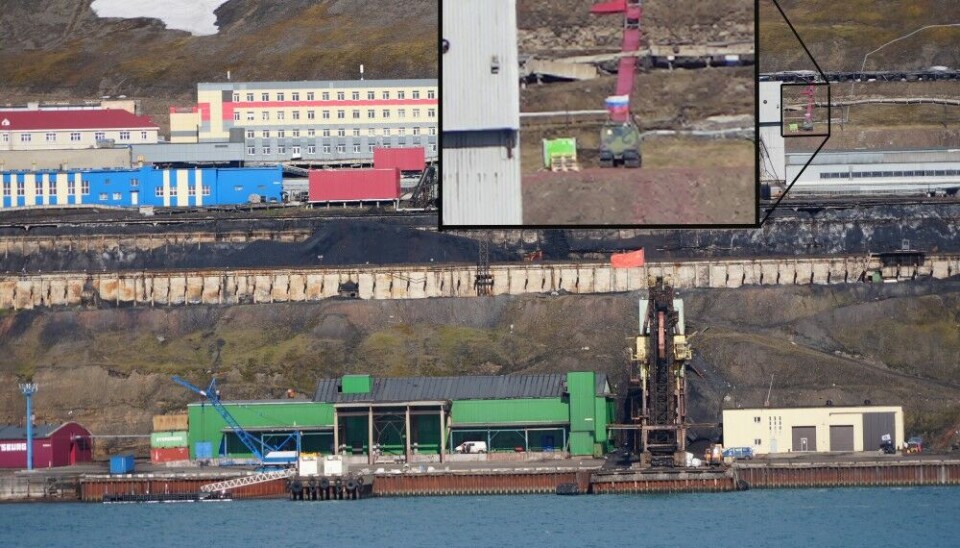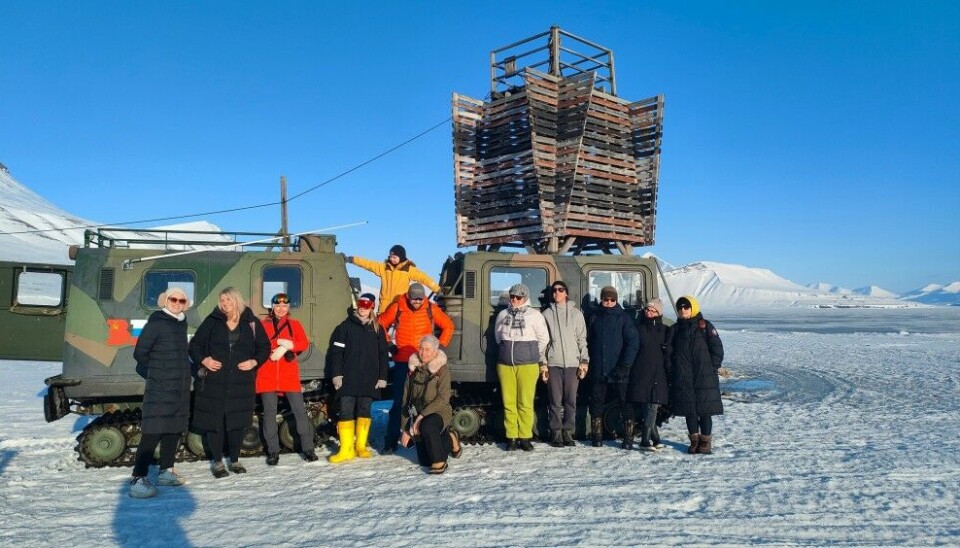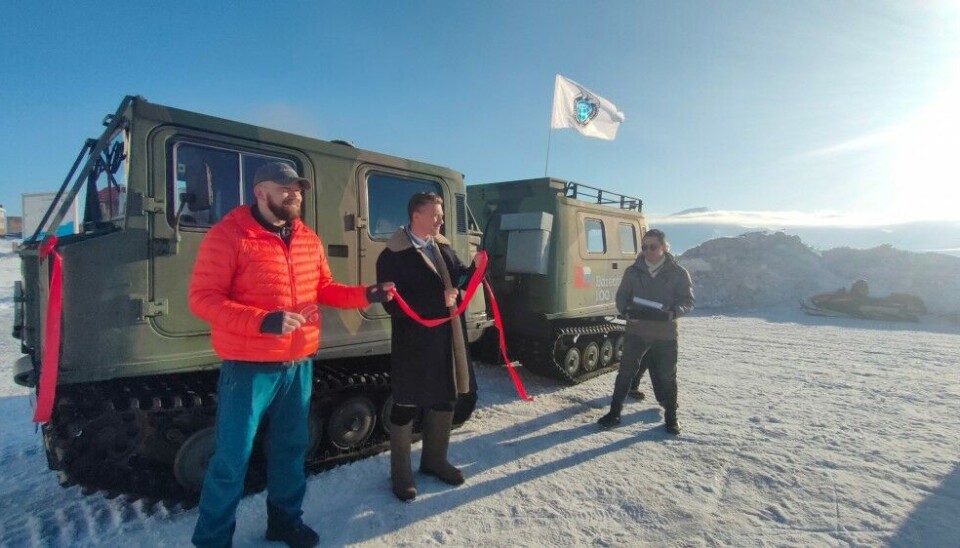
At Svalbard, Russia now manoeuvres a camo-painted all-terrain vehicle originating from Norwegian Armed Forces
The Hägglund BV206 was specially developed for the Norwegian and Swedish armed forces to carry up to 17 combat equipped soldiers through snow and bog-lands in northern Scandinavia. Now, one of them has ended up in Barentsburg and drives around with a big Russian flag.
With original camouflage paint from the days it was on duty for the Norwegian Army, the tracked articulated all-terrain carrier officially belongs to the Russian ‘Tour Club’ in Barentsburg.
“The vehicle reaches speeds of up to 50 km/h, and can navigate any off-road terrain,” Arktikugol wrote on Vkontakte as the BV206 was taken into use on April 25.
Aktikugol is the state-owned company running all Moscow’s operations at Svalbard.
The only visible adjustments made to the vehicle is the logo of the tour club painted on the front door and a Soviet-Russian flag logo for Barentsburg’s 100th anniversary painted on the rear tracked wagon.
The Barents Observer could in late June see the military-ish vehicle from the sea-side in Barentsburg. A big, waving, Russian flag was attached. The BV206 stood parked next to Krasniy Medved (Red Bear), the local restaurant and bar.

In early May, one mission with passengers across the snow-covered permafrost at Svalbard went to Kap Heer where the Victory in Europe Day was marked by the Consulate General and Arktikugol. Although no Soviet-Russian citizens participated in World War II fightings at Svalbard, marking the end of the war has since 2022 become a key tool in Moscow’s propaganda operations at the Norwegian Arctic archipelago.
In Moscow, Victory Day is celebrated on May 9th. This year with Vladimir Putin overlooking the military parade on the Red Square and giving a speech where he accused the West of risking a global conflict.

The Norwegian Armed Forces still operate about 650 BV206. Many are recently upgraded and will be in operation until at least 2030.
From 2005 to 2009, however, when Norway’s re-armament period was in full swing, many were sold. Mainly to allied and friendly countries like Latvia, Lithuania, Finland and Germany. 14 of the German-owned vehicles has post-2022 been re-exported in support to the Ukrainian Armed Forces.
Norwegian newspaper Dagbladet discovered in 2015 that several of the BV206 were sold to Russian companies and persons. Nobody knows exactly how many of the Norwegian military vehicles ended up in Putin’s Russia.
Today, export of all military equipment to Russia is sanctioned by the European Union.
Sweden, which produced the BV206, on April 30th this year tightened its act on transfer of military hardware, including tracked all-terrain vehicles. To be legally disposed of, at least one clear line of paint must cover the original military paintings, the Swedish definition reads.
A quick search avito.ru shows several BV206 for sale inside Russia at prices ranging from 3 to 4 million rubles. Some are repainted, others still carries Norwegian camouflage colors.
Few would believe that one of them would end up in Barentsburg, driving around with a Russian chauffeur and a big flag of the country that has named Norway “very unfriendly”.
Norway has the full and absolute sovereignty of Svalbard. The archipelago is also included to the map of NATO’s responsibility hanging on the wall in the headquarters in Brussels.
Not illegal
Svalbard Governor Lars Fause says his office is aware that the vehicle came to Barentsburg this winter.
“It has probably been used by the Norwegian Armed Forces for many years, presumably legally disposed of by the military before it eventually ended up at Svalbard in Barentsburg,” Fause says in an email to the Barents Observer.

The Governor says there are several tracked vehicles at Svalbard, but the others are not painted in military colors.
“We monitor whether they follow road traffic legislation and the Svalbard Environmental Protection Act,” Fause says.
Tracked all-terrain vehicles, like the BV206, are great at getting around in Arctic climate, summer and winter. UNIS, the University Centre at Svalbard, has several blue-painted such tracked wagons to support the natural science researchers and students.
That a Russia state-owned operation drives around with Norwegian military camouflage is a whole different story. Especially in times of war.
















